One of the many cool things about making soap is that there are a lot of techniques to choose from. I started out using the cold process method, but recently have been making all of my soaps a different way. My now preferred method is a form of hot process, which is like the name implies, uses heat in the soap making process. I wrote about this technique in an earlier post. Some people think that the reason people do HP is that you can use the soap right away. While that is somewhat true, the benefits for me are quite different. Before I get into those benefits, I am going to share my exact process for HP because again, there are quite a few techniques to pick from. I learned my technique from the amazing and talented Sharon Johnson so I in no way, shape or form came up with this idea. I am just passing along the knowledge that Sharon was incredibly generous to share. Here are a few soaps I have made with this process.
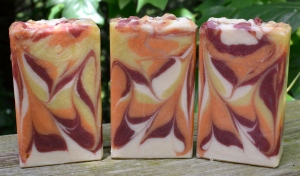
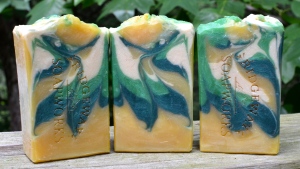
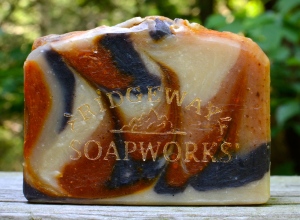
A few things I would like to say before I walk through the process.
1. If you have not made soap before, I recommend getting a few basic soaps under your belt first. Check out Soap Queen TV for a wide array of tutorials and recipes. This technique only started really working for me once I understood what happens chemically during the soap making process and a few beginner recipes would be invaluable in gaining that knowledge and experience.
2. I am by no means an expert on this technique as I am still learning myself
3. Thanks to Sharon Johnson, Jami Summer & Katona Wright for sharing valuable knowledge with me about HP
OK! Let’s get started. This process starts out like regular HP – melt your oils in the crock and mix your lye with water. I prefer to use 38% water, although others who use this technique like 40%. (note: one reason why this is not a beginner recipe – you would learn what the 38% means once you make a few batched). With 40% my bars were too soft which may be a function of my recipe. I recommend a recipe what generates harder bars but that is not completely necessary if you have a recipe that you like.
Before I start, I like to get all my colors, additives, mold & fragrance all set up so once the cook is done, I have everything handy. When I have not done this, I have forgotten some of the additives like fragrance.
I like to let my lye water cool for about 20+ minutes because I think the soap cooks more gently. When I have added very hot lye water to my oils, the soaps cooks very very fast and has become overcooked on a few occasions. I stick blend the mixtures until it reaches light trace.
Next you “DITCH THE LID”. That simply means cover your crock with plastic wrap. I don’t remove the saran to stir. I let it be until it does its thing. I used to stir so I get why you want to do that. I suggest that you don’t however as you will let the steam escape and lose some fluidity in your soap batter.
After the cook starts, I keep an eye on things. See how the soap is starting to gel on the left side? The soap always cooks from outside inwards because of where the heat it. It can be hard to see in the photos because of the steam on the plastic wrap.
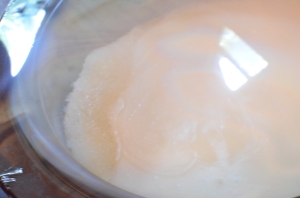
I also check the temps. I don’t want it to get too much over 180 (but that has happened and the soap was still ok).

ok – here is where I take off the wrap. It is almost done gelling but not quite. The part in the lower middle is not done gelling but this is still where I stop this phase of the cook.
At this point I stir with a whisk and add my superfat, full fat greek yogurt (1T ppo), coconut milk (1 T ppo), sodium lactate (1 t ppo) and sometimes kaolin clay (1/2T ppo). Whisk whisk whisk and then I put the actual crock cover on and wait a few minutes (3-5 but i am not always that patient). This wait time converts the batter in a smooth, fluid, pourable soap!
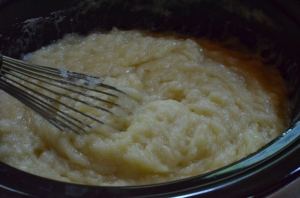
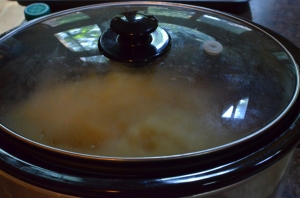
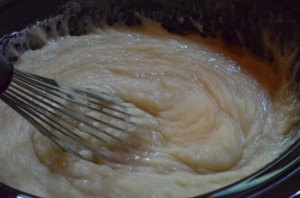
Now it is time to split up the batter, add color, wait a little and then add fragrance.
Below is my attempt at taking a photo pouring the batter into the mold. My batter is pourable but it is a different texture than CP so don’t expect it to be exactly the same.
I did not take any more photos while pouring the batter, but here is the mold full of soap!
I did swirl up the top a bit after taking this photo. After this step, I let my soap sit for a while to cool and then pop it in the freezer for a few hours.
And then comes the absolute best part!! The cut.
Note: I make sure to gently warm my yogurt and whisk it smooth. Want to know why? Because one time I did not. Note the brown specks that are not supposed to be in this soap.
If you are still reading then you must be pretty interested in learning more about the hot process of soap making.
So why do I prefer this method over traditional cold process?
1. No worry about acceleration from a fragrance oil. I still get very anxious when making a CP soap that when I add my fragrance it will accelerate trace and make my the pattern I have planned impossible. Not an issue with HP because you add fragrance after the cook
2. Less morphing of colors. Again, colors are added after the cook so they are not present in the soap when it goes through saponification
3. No worry about gel / partial gel / ungelled soaps. All HP soaps go through the gel phase. With CP I had quite a few soaps overheat because of additives such as honey and goat milk and the soaps had to be rebatched. I also have had quite a few soaps go through partial gel which is again not what I wanted to happen
4. I control the superfat. I like to use skin softening oils like cocoa butter and shea butter as my superfats in HP. Because they are added after the cook, I know that they are not going to turn into soap. With CP you have no idea which oils ended being the super fat.
5. The clean-up is SOOOO much easier with HP. You are washing soap out of your crockpot and off your tools. With CP everything is a greasy mess that never seems to actually get clean.
6. The cure time is sometimes less. However, I still let my soaps harden for 2-4 weeks so that they last longer.
Do I still do CP? Yes, I like to make a goat milk soap that is a nice creamy white and I have not figured out yet how to do that via HP (it turns a light brown from the heat) so I still make that soap using cold process. I could just add a little goat milk after the cook but I love this soap made with 100% goat milk as the liquid so I would need to add it before the cook.
Thanks for reading! Happy soaping.



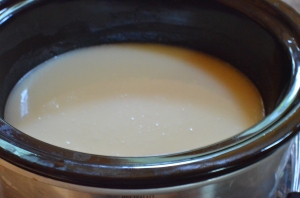
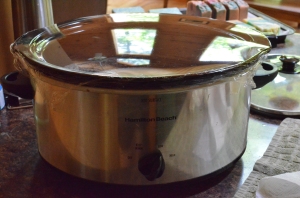


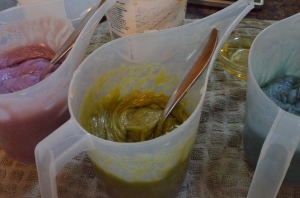
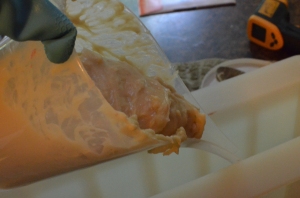
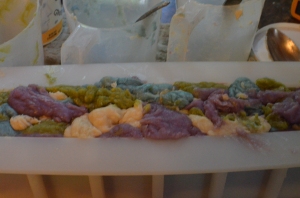
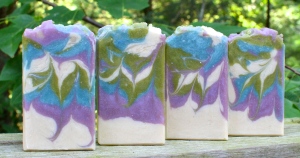
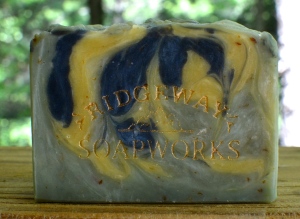
Awesome info and instructions! Thanks. I prefer HP as well so will be trying this soon!
LikeLike
Good luck Roxy! Let me know how it goes for you.
LikeLike
Oh my gosh! I think you have just saved my sanity!!! I was having so much trouble since I went back to CP so I could get the swirls I was ready to throw everything out. I’ve never had problems with EO’s & FO’s until I went back to CP! All because I wanted the ” pretty ” bars. I’ve been soaping for 16 yrs. Thanks for all this info. I’m going to try it tomorrow.
MaryAnn
Jefferson, Ga
LikeLike
You are most welcome MaryAnn! Good luck!!
LikeLike
Your soaps are beautiful!!!
MaryAnn
Jefferson, Ga
LikeLiked by 1 person
Thank you!
LikeLike
Wonderful tutorial. Thank you so much! I am going to try this method !
LikeLike
Thank you Gayle! Give it a try – once I did, I never looked back!
LikeLike
Thank you for sharing this excellent tutorial! Your easy to understand instructions and photos tempt me to try this hot process soap making technique.
LikeLike
Thank you Ewenique! Give it a try and let me know how it goes for you.
LikeLike
This is very informative – thank you! Ditch the hot lye too – how long is your 2nd mini cook?
LikeLike
the second mini cook is short – about 3-5 minutes. Just enough time to allow the yogurt and milk to do their thing and make the batter fluid. I took the crock out of the base thing today for that second part to help it cool down a little quicker. Thanks for stopping by!
LikeLiked by 1 person
Great info, thank you for sharing, I’m quite a newbie to soap making but loving hp and learning lots of new tips.
LikeLike
Thanks Debbie! HP is great! Glad you found the post informative.
LikeLike
When you start your initial cook is your crock pot on the lower setting or on high? Have only done CP but want to try this. Also can I use a Cp recipe or does it gave to be a Hp recipe? Thanks for the tut. Was great.
LikeLike
I always keep my crock on low. I tried to cook on high once and it boiled over the pot, spilling half the soap on the counter and overcooking the rest. I have thought about melting the oils on high and switching to low and am too worried that I may forget to switch. So, i play it safe and cook on low. You can use any CP recipe to make soap via HP. You are just speeding up the saponification process. If you superfat your soaps, you may want to pick one of your conditioning oils (shea, cocoa, etc.) to add after the cook so that it does not saponify. This is one of the benefits of HP – you can decide if you like which oil is the superfat by adding it later.
LikeLike
Love your soaps. I am new to soap making. How did you get some parts white in your soap? Thanks
LikeLike
I use titanium dioxide which I mix with oil. 1t TD with 1T oil. I actually premix this colorant in a squeeze bottle because I use it so often and it sometimes takes more time to fully mix in.
LikeLike
Thanks
LikeLike
Thank you for this tutorial. I tried the other method with the 40% water a week ago, it volcanoed over and it is still soft to the touch, more so than any CP soap I have ever made. Will try this one out and let you know how it goes. Yours sounds so much easier.
LikeLike
Give it a try Alison! Stop by again once you have made your soap and let me know how it went.
LikeLike
Wish you had shown how you swirl and pour in layers of color. I know that would be hard to do w/o video.
LikeLike
Hi Judy,
I plan to do more tutorials on how I swirl, but am not sure it will be a video. Being videotaped makes me nervous so I am sure that I would completely botch the soap is I was on camera!
LikeLike
Morning Judy,
Bravo! Well done!! Great appreciation for your clear, simple HP steps.
I have a few questions related to the fact that I’m allergic to corn and all it’s derivatives. Brambleberry’s sodium lactate (sl) is derived from corn. Where do you by your sl? Do you know if it’s a corn derivative? Have you made test batches without sl? I’ve read that it’s the sodium lactate that makes the gelled soap fluid enough to swirl.
Thanks again for all your hard work creating a regular newsletter and tutorials,
Leela
Swirling Sky Soap
LikeLike
Hi Leela, I sometimes get SL from Nature’s Garden – it does not say on their site what it is made from but you could email them. I sometimes use stearic acid in place of SL. I think that is made from palm. Back to SL, it is a salt, and I think that some people just add a small amount of sea salt to their water before the lye to get the same result but I have not done that yet. I think it is actually the yogurt that makes the soap very fluid for the swirls. I have forgotten to add the SL a few times and it does not affect the swirls, but it does make the soap take a little bit longer to harden. Thanks for your feedback! Molly
LikeLike
Awesome post and tips. I made two batches of HP today and used your plastic wrap advice and adding the yogurt and a 3-5 minute mini cook and was amazed at the fluidity I had. Thanks so much! Now, I am impatiently waiting for the unmold and cut lol torture sheer torture I tell ya!
LikeLike
Isn’t it amazing how this technique makes such a difference!! And i agree waiting for the cut is the hardest part!
LikeLike
Hi Molly! I am relatively new at this but have made several batches of HP. I can’t wait to try this “ditch the lid” process tomorrow! My previous batches have just been the regular crock pot variety. I do have a couple of questions, if you don’t mind. You say that you SF with nourishing oils. Do you add them in addition to the yogurt? Also, you say to add the fragrance after the batter has been divided. How exactly do you do that? I have been adding it do the whole batter and dividing after. Sorry so long but I want sooooo much for this to work! I am so excited! Thank you for the great info. It is a fun tutorial to follow.
LikeLike
Hi Denise,
I add my SF (usually cocoa butter, shea butter or hemp oil) in addition to the yogurt and add them both after the cook. I will divide my cooked soap into separate mixing bowls, add the colorants, and then add the fragrance to each color. I put the color in a small glass bowl and then just pour some in each bowl. I think that it helps prevent any fragrance burning off because the soap is cooler at this point. good luck! I would love to see a pic of your soap once you are done.
LikeLike
Does the yogurt or milk go bad because you added it after the cook?
LikeLike
Hi Helga, not the milks go not mold or spoil because of the pH of the soap. It is too high of a pH for bacteria to grow.
LikeLike
Thank you for this fantastic, clear and concise instructions. Your soaps are so gorgeous and I will try to follow your instructions. I spent so much money trin different hp methods.
Thanks again!
Lisa 🙂
LikeLike
Thanks so much Lisa!! Happy Soaping!
LikeLike
I was wondering what do you use to get your really bright colors? I’ve tried micas but I may be just not putting enough in. Can you share what you use and how much to get the really nice bright colors. Thanks!
LikeLike
Oops! Please forgive me, I just found your post on colors. Thanks!
LikeLike
One other question. So I just made 3 batches following your directions except I didn’t have any coconut milk.
Batch #1 I used sodium lactate and yogurt, used EO’s so I let the temp get to 134 and it was pretty stiff but I was able to get it in the mold and stir with spoon.
Batch #2 no sodium lactate only yogurt, used Fragrance oil temp 165, still very stiff and had to stir colors with a spoon.
Batch #3, 1/2 batch and I was trying to get it to cool down to put peppermint oil in and at 150 it was turning so stiff I had to use my hands to just get it in the mold.
Do you think leaving out the coconut milk was what made it so stiff? I really want to get this work.
I used a 30% olive oil, 30% coconut oil, 30% palm oil, and 5% each caster and avocado recipe. Maybe the palm made it so stiff?
Any suggestions? Thanks!!
LikeLike
That is a fairly high percentage of Palm oil – You could lower the palm to perhaps 26% and raise castor and avocado (or olive) up by 2% each. That might make a slightly more fluid soap…
LikeLike
One more thing…sorry to be a pain but I really want to get this down. I tried the coconut milk and it did help some but I am getting hard lumps in my soap that are creating white spots in my colors. How do I keep those out of my soap? Thanks so much for the help!
LikeLike
Did you heat the coconut milk before adding? I always heat all my post cook additives otherwise they cause the soap to cool really quickly and that results in white spots. good luck!
LikeLike
Nope, I didn’t heat. I will give that a try. Thanks!
LikeLike
I know when you scrape the sides of the pot it will add the cooked soap from the sides and you will get those chunks in your finish product.
LikeLike
Yes! This happens to me and no beuno!!
LikeLike
So I’ve made about 20 batches and just can’t seem to get the color to turn a nice white in the HP. I am using 30% olive, 30%, coconut and 30% palm. It works fine when I put the titanium dioxide in the CP but it doesn’t get white with the HP. When I add more it just puts white lumps in my soap (even after blending first with the hand blender in the oil to mix it up). Can you suggest how I put nice white in my HP? Is it the olive oil? Thanks!!
LikeLike
Tawra – I had this problem too and it drove me crazy! I thought it was my TD so i kept buying different ones. i finally realized i was adding my colors when the soap was too hot. i now let it rest until close to 200 F, then add my yogurt and other additives, let it sit another minute or two, and then split / add colorants. this made a huge difference for me and was not a sacrifice in fluidity which I feared it would be.
LikeLike
Hum…well I’m adding it around 180. I will try 170 and see. It’s driving me nuts too! I have a lot of bars of nice looking beige soap but really wanted white. 🙂
LikeLike
I was wondering about the goats milk soap that you said you had to CP … I read about this method and have been using it for all my goat milk soaps…. Maybe it will work for the recipe you have… I use goat milk powder. Whatever the amount of water or liquid is that you use, add the correct amount of powder to make that amount of liquid milk… Example my powder is 2 unpacked level scoops w/ 3/4 CP of water, makes 1 CP of milk. So if you used 6 oz of water or liquid, you could add 2 scoops of powder after the cook and it would be the same as using 100% goats milk. I’m not sure that the properties of the final soap would be the same because of doing this or not. I was just wondering if you had tried this… Love your tips and your soaps are beautiful! Look forward to learning more from you. Thank you so much!
LikeLike
Hi Crystal! Thanks for stopping by. I have not used powdered goat milk in my soaps (i do use it in lotion though) because I have easy access to fresh goat milk. However, many soaps I know use powdered with fantastic results so i see no reason why it would not add the same beneficial properties. Happy Soaping!
LikeLike
Nice and istructive post! Congratulations!
One question: What is 1T ppo? Is 1 tea spoon? I’m from Spain and searched what is but didn’t find.
Best regards.
LikeLike
1T is a tablespoon. 1t is a teaspoon.
LikeLiked by 1 person
Thank you very much Molly 🙂
LikeLike
Hi Molly,
Thank you for the wonderful article on Hot Process soap making. I have made 25-30 batches of cold process but never Hot Process. It is on my short to do list, that is where you come in. Today I am doing research and you have so kindly “detailed” the process. It is the very best information I have found on CPHP soap making. I do have 3 questions if you don’t mind Molly.
Regarding the flashpoint of Essential Oils & Fragrance Oils. Please, correct me if I am wrong, I read (somewhere) if they are added to soap hotter than their flashpoint it renders the EOs or FOs unless – it kills it, so to speak. What can you tell me about this Molly?
Secondly, I love to make up my own recipes. If I was to hot process a CP Pumpkin Soap recipe, am I correct in saying, I add the pumpkin puree at the end like you did the yogurt? Also could I add yogurt too?
Thank you so much. Looking forward to hearing from you.
Darlene
Nova Scotia
LikeLike
I live in Alberton , in South Africaa, new to soamaking😜And hav e had a few blunders. I like the texture of cold proces and the fluidity of the “batter” but you have given me so many tips, I think I will persevere with HP and see if I can acheive the same results, hold thumbs, I am going to do my best😉
LikeLiked by 1 person
Best of luck Patsy!
LikeLike
Do you think coconut Greek yogurt would work? It’s smooth – no flakes of coconut just flavour – but it’s what I have on hand.
LikeLike
It may! Give it a try.
LikeLike
Thank you so much for your tutorial, I loved it! I’ve tried this method a couple times, and loved the outcome, with the exception of one thing. Whenever I add the yogurt, my batter turns a deep deep copper brown. I’m adding the you gift at about 170deg. What am I doing wrong? Is it the sugar added to the lye water??
Tami
LikeLike
hhm, that has never happened to me. i have added goat milk when the soap was too hot and it turned brown, but if i am careful to never add dairy until <180 i dont have any issues with discoloration.
LikeLike
How do you know how much oils (like cocoa butter) to add at the end, to achieve the desired percentage of superfat?
LikeLike
It is up to you how much to add, but i usually add 5% superfat after the cook.
LikeLike
Hi Kelly – if you run your recipe through a lye calculator: first with 5% superfat, then again with zero superfat – you can get an idea of how much to add at the end.
Try http://www.soapcalc.net – that is a really good calculator… hope that helps…
All the best, Wendy
LikeLiked by 1 person
Wow! I am so impressed by the excellence of your website and your stunning soaps AND your products! So creative. I run a small home business by making soaps and beauty products. I have been using the HP method for years but due to the ‘demand’ for pretty soaps and swirls I started making CP soaps. I have ALWAYS had something wrong. Either cracked tops due to overheating, morphing colors, partial gel etc etc…I have since discovering your site made 2 bathes of HP and I love love love it! I have new hope for HP technique.
LikeLike
Thanks so much!
LikeLike
Only happen to have on hand low fat plain greek yogurt and also flavored vanilla greek yogurt. Would the “non-fat” and the “vanilla flavor” component be detrimental in this process? Just thought I’d see if you’ve had any experience with either…? Thanks so much for your great info…so generous for you to share and for all the time you take to reply!! 😉
LikeLike
Hopefully you don’t get this twice…I just entered this question and it doesn’t show up. Have you had experience using low-fat or non-fat plain greek yogurt? Also I have a low-fat vanilla greek yogurt on hand. Wasn’t sure if the “low/non fat” or the “vanilla flavor” component would negatively effect the outcome of the soap…or if you’ve ever tried. : ) Thanks so much for all the info you’ve so generously shared.
LikeLike
I have used non-fat and flavored with no issues. happy soaping!
LikeLike
Whoa – flavored yogurt? Does it leave any scent? Interesting!
LikeLike
Hi. I love this method and have had great success until recently. My Soaps have white spots in the last 4 batches. Please help me!!! I can’t afford to keep making these mistakes.
* 33 oz coconut oil, 76 degree* (where to buy coconut oil)
* 4.83 ounces lye (NaOH)** (where to buy lye)
* 12.54 oz water
Tussah Silk
2T Greek yogurt
2T Coconut Milk
2T Kaolin Clay
2T Colloidal Oats
2t sodium lactate
1 oz. water
1.6 oz BB Cocoa Butter Cashmere FO
LikeLike
My experience with white spots is A) overlooked soap- when scraping the sides of the crock and mixing it in- has resulted in these white spots or B) undissolved or “uncooked” lye
If it’s uncooked lye – you can re-batch it… but if it’s over cooked soap.. well you’re kinda stuck with it, as far as I know anyway.
Maybe someone else has another explanation that’s just been my experience. Hope it helps…
LikeLike
Please forgive me if this is annoying?!?!?
I did scrape the sides, Does that mean do not scrape the sides?
How can I tell the difference between under cooked lye and overlooked lye?
Should I rebatch anyway? How do u do that? My last rebatch is still soft after 7 months.
LikeLike
If your sure your lye was dissolved before adding to fats and you know your soap went through the gel stage then you’re pretty safe .. lye spots are more of an issue in cold process.
If you scraped the sides then I’d bet that’s where your white spots are coming from. So the small bits on the sides that no longer have a translucent look – those are the bits that will give you the white spots. I personally spoon my soap into the mold or prewarmed glass measuring cups when adding colours, avoiding the edges near the top – then go back and scrape the edge of the crock and make a soap ball – it’s still good soap and it’s also gives you an idea of lather etc for that batch of soap.
LikeLike
I’m new at soap making,I have only done the HP.My question is about the sodium lactate, I have never used it and wanted to know what temperature should my soap be before adding the sodium lactate.
LikeLike
many people add sodium lactate to their water before adding lye, or after the cook with additives like goat milk. I dont think that the temperature of the sodium lactate matters.
LikeLike